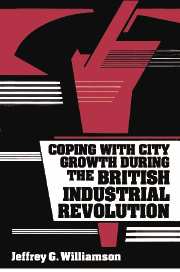Book contents
- Frontmatter
- Contents
- List of tables
- List of figures
- Acknowledgments
- 1 Coping with city growth, past and present
- 2 The urban demographic transition: Births, deaths, and immigration
- 3 Migrant selectivity, brain drain, and human capital transfers
- 4 The demand for labor and immigrant absorption off the farm
- 5 Absorbing the city immigrants
- 6 The impact of the Irish on British labor markets
- 7 Did British labor markets fail during the industrial revolution?
- 8 Did Britain's cities grow too fast?
- 9 City housing, density, disamenities, and death
- 10 Did Britain underinvest in its cities?
- References
- Index
6 - The impact of the Irish on British labor markets
Published online by Cambridge University Press: 03 May 2010
- Frontmatter
- Contents
- List of tables
- List of figures
- Acknowledgments
- 1 Coping with city growth, past and present
- 2 The urban demographic transition: Births, deaths, and immigration
- 3 Migrant selectivity, brain drain, and human capital transfers
- 4 The demand for labor and immigrant absorption off the farm
- 5 Absorbing the city immigrants
- 6 The impact of the Irish on British labor markets
- 7 Did British labor markets fail during the industrial revolution?
- 8 Did Britain's cities grow too fast?
- 9 City housing, density, disamenities, and death
- 10 Did Britain underinvest in its cities?
- References
- Index
Summary
Irish immigration and the labor-surplus model: Three questions
To add to all the other social problems that Britain's cities had to face during the First Industrial Revolution, they also had to absorb the Irish. Rapid growth after the French wars made the absorption easier, but the Irish immigrants still serve to complicate any assessment of Britain's economic performance up to the 1850s. Would the cities have been able to cope with growth far more easily in their absence? Would common labor's living standards in the city have risen much more rapidly? Was rural out-migration strongly suppressed by Irish competition in Britain's cities? Was migration from the agrarian South deflected from northern cities by a glut of Irish labor? Did British industrialization receive a powerful boost by an elastic supply of cheap Irish labor?
Did the Irish depress the standard of living of British labor?
Qualitative accounts suggest that Irish immigration into Britain did not really become important until after the French wars, the 1820s often being offered as the benchmark decade. It is also true that unskilled labor's real-wage gains lagged far behind during the otherwise impressive secular boom up to the 1850s (Lindert and Williamson, 1983). Inequality was also on the rise (Williamson, 1985a), suggesting that the Irish glut at the bottom of the distribution may have played an important role.
The gross correlation is seductive, lagging living standards and rising inequality coinciding with Irish immigration, but a clear assessment has always been clouded by the difficulty of controlling for everything else.
- Type
- Chapter
- Information
- Coping with City Growth during the British Industrial Revolution , pp. 129 - 177Publisher: Cambridge University PressPrint publication year: 1990



